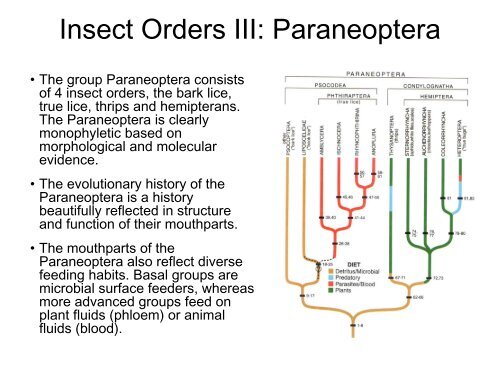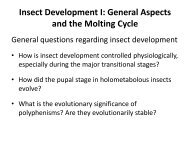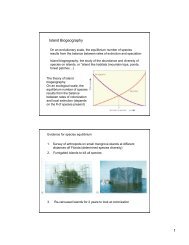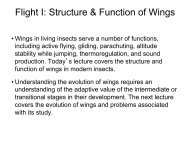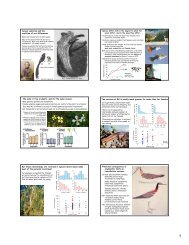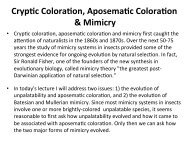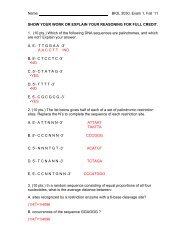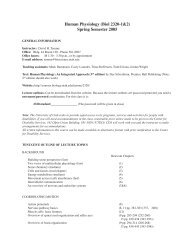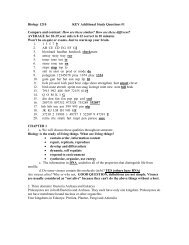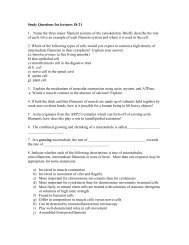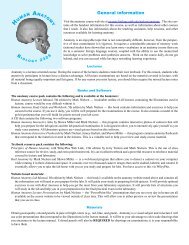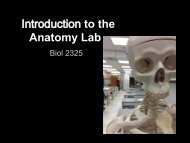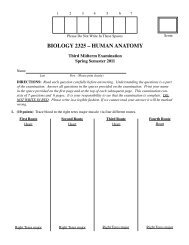Insect Orders III: Hemipteroidea - Biology Courses Server
Insect Orders III: Hemipteroidea - Biology Courses Server
Insect Orders III: Hemipteroidea - Biology Courses Server
Create successful ePaper yourself
Turn your PDF publications into a flip-book with our unique Google optimized e-Paper software.
<strong>Insect</strong> <strong>Orders</strong> <strong>III</strong>: Paraneoptera<br />
• The group Paraneoptera consists<br />
of 4 insect orders, the bark lice,<br />
true lice, thrips and hemipterans.<br />
The Paraneoptera is clearly<br />
monophyletic based on<br />
morphological and molecular<br />
evidence.<br />
• The evolutionary history of the<br />
Paraneoptera is a history<br />
beautifully reflected in structure<br />
and function of their mouthparts.<br />
• The mouthparts of the<br />
Paraneoptera also reflect diverse<br />
feeding habits. Basal groups are<br />
microbial surface feeders, whereas<br />
more advanced groups feed on<br />
plant fluids (phloem) or animal<br />
fluids (blood).
Modification of mouthparts in the Paraneoptera<br />
• Mouthparts in the Paraneoptera<br />
show a striking evolutionary trend<br />
from the most generalized<br />
“picking” mouthparts of the<br />
Psocoptera with standard insect<br />
mandibles to the probing and<br />
puncturing mouthparts of thrips<br />
and anopluran lice and the<br />
distinctive piercing-sucking<br />
rostrum or beak of the Hemiptera.<br />
• In these evolutionary transitions<br />
the mandibles become greatly<br />
reduced and modified. The<br />
laciniae of the maxilla, in contrast,<br />
become enlarged and modified<br />
and together with the mandibles<br />
form the stylets of the Hemiptera.
Psocoptera (Bark lice)<br />
• Classification. 4,400 described species<br />
arranged into 3 suborders (Trogiomorpha,<br />
Troctomorpha and Psocomorpha) with 50<br />
families and over 200 genera. First insect<br />
order to show the beginnings of a<br />
transition to sucking mouthparts. Sister<br />
group to the Phthiraptera (the lice).<br />
• Structure. Lacinia of the maxilla is<br />
modified from the dentate form in<br />
orthopteroids into an elongate rod-like<br />
structure, proximately sunken well into the<br />
head capsule. The hind coxa of most<br />
psocopterans has a Pearman’s organ with<br />
an adjacent tympanum that is suppose to<br />
be stridulatory. Postclypeus on the face is<br />
budging as are the eyes.<br />
• Natural history. Psocopterans are found<br />
on foliage or branches of trees and shrubs<br />
or under bark or leaf-litter. Most species<br />
are micobial surface feeders, some<br />
species feed on dead insects and a few<br />
species eat paper products (booklice).<br />
Many species live gregariously similar to<br />
webspinners and zorapterans. Mating<br />
behavior can be elaborate with the male of<br />
at least one species standing on its head.
Phthiraptera (True lice)<br />
• Classification. 5000 described species divided into 4<br />
suborders. The Amblycera (chewing lice) is the most<br />
basal group and parasitize birds and mammals. The<br />
Ischnocera (chewing lice) is the largest suborder and<br />
parasitize mostly birds and some groups of mammals.<br />
The Rhynchophthirina (elephant lice) consists of only<br />
3 species that parasites elephants and wild pigs in<br />
Africa. The Anoplura (sucking lice) parasitize only<br />
mammals.<br />
• Structure. Body is dorso-ventrally flattened and well<br />
sclerotized. Wings absent. Eyes absent or nearly so,<br />
antennae reduced to 3-5 segments. Legs strong with<br />
well-developed tarsi for holding onto fur or feathers of<br />
host. Amblycera have chewing mouthparts with lacinia<br />
modified as in Psocoptera. Anoplura have true sucking<br />
mouthparts with stylets.<br />
• Natural history. All species of lice are parasitic on all<br />
orders of birds and most orders of mammals<br />
(monotremes, edentates and cetaceans are not<br />
attacked). Chewing lice feed on feathers, hair and skin<br />
surface detritus, whereas sucking lice feed exclusively<br />
on blood. Most species of lice are host specific, with<br />
the sucking lice being more host specific than chewing<br />
lice. There is strong evidence for host-parasite<br />
coevolution in some groups. Because lice are wingless<br />
transfer between hosts usually involves direct contact<br />
during mating, brooding and nursing of young, sharing<br />
of communal nest sites or even during predator-prey<br />
interactions. Lice have the fewest number of life<br />
stages of any insect (egg, 3 larval instars, adult).
Thysanoptera (Thrips)<br />
• Classification. 5500 species classified into two suborders<br />
distinguished by the ovipositor. Terebrantia have a well-<br />
developed conical ovipositor, while the Tubilifera do not<br />
have a well-developed ovipositor. Instead the abdomen is<br />
drawn out in the shape of a tube.<br />
• Structure. The mouth is in the form of an asymmetrical<br />
“mouth cone”, consisting of a piercing left mandibular<br />
stylet (right mandible lost) and lacinial stylets. Thrips have<br />
unique eversible bladders on their tarsi that provide<br />
adhesion to the substrate. Wings, when present, are linear<br />
with long marginal setae that look like fringe (hence the<br />
name of the order). Polymorphism in wings and body form<br />
is common in the order. Males in some species are<br />
distinctly dimorphic. Wingless males have enlarged heads<br />
that they use in competition for females, whereas winged<br />
males lack enlarged heads and disperse in search of<br />
females.<br />
• Natural history. Thrips are commonly found on and in<br />
flowers. Most species are phytophagous, feeding on<br />
flowers. Some species feed on fungi and a few species<br />
are predaceous. Development in thrips is unique. In the<br />
Terebrantia the egg stage is followed by 2 larval instars, 1<br />
“prepupal” instar, a “pupal” instar and the adult stage. The<br />
prepupal and pupal stages are quiescent and have<br />
rudimentary wings. In the Tubilefera there are two<br />
“prepupal” instars and one “pupal” instar. Wing rudiments<br />
are not present in the first “prepupal” stage. Social<br />
behavior ranges from solitary to eusocial with reproductive<br />
division of labor.
Hemiptera: Sternorrhyncha (aphids, plant lice<br />
& scale insects), Auchenorrhyncha (Cicadas,<br />
plant hoppers & leaf hoppers)<br />
• Classification. The Hemiptera are divided into 3 major<br />
suborders, the Sternorrhyncha (10,000 species),<br />
Auchenorrhyncha (25,000 species) and Heteroptera<br />
(see next slide).<br />
• Structure. All species have well-developed piercing-<br />
sucking mouthparts usually placed well back from the<br />
front of the head. Front wings are uniformly thickened or<br />
membraneous and are not of the hemelytron type. Body<br />
form of some groups such as the scales are highly<br />
modified (females wingless and usually legless).<br />
• Natural history. All species in the Sternorryhncha and<br />
Auchenorrhyncha are phytophagous, with some being<br />
very specialized and others quite generalized. Many<br />
groups are tended by ants, including aphids,<br />
membracids and scales. They provide ants honeydew in<br />
exchange for protection from predators. Some cicadas<br />
have unusually long life cycles and emerge as adults<br />
only after 13 or 17 years. Aphids have polymorphic body<br />
forms that are correlated with host plant alternation and<br />
parthenogenetic reproduction. Winged sexual forms<br />
move between host plant species, while apterous<br />
asexual forms are sedentary and grow rapidly on host<br />
plants. Scales are sessile and spend their life under a<br />
protective waxy covering. Males emerge from their waxy<br />
covering and seek out females for mating. Many scales<br />
have unusual genetic systems.
Hemiptera: Heteroptera (True bugs)<br />
• Classification. Over 20,000 species classified into 7<br />
infraorders. Major infraorders include the<br />
Nepomorpha (aquatic bugs), Gerromorpha (semi-<br />
aquatic bugs), Cimicomorpha (assassin bugs, leaf<br />
bugs, bed bugs), and Pentatomorpha (seed bugs,<br />
squash bugs, leaf-footed bugs, stink bugs). Over<br />
50% of described species are from three mostly<br />
phytophagous familes (Miridae, Lygaeidae<br />
Pentatomidae).<br />
• Structure. In most Heteroptera the basal portion of<br />
the forewing is thickened and leathery and the apical<br />
portion is membraneous. This type of wing is called<br />
a hemelytron. Piercing-sucking mouthparts that are<br />
placed at the front of head.<br />
• Natural history. Feeding habits extremely varied.<br />
Most species are phytophagous, feeding on seeds<br />
or piercing plant tissue and feeding on xylem or<br />
phloem. Most aquatic species are predaceous as<br />
are some terrestrial families such as Reduviidae,<br />
some of which feed on blood. Many species have<br />
repugnatorial glands that release noxious chemicals.<br />
Nymphs of many Miridae reduce predation by<br />
mimicking ants. In bed bugs fertilization occurs when<br />
the male punctures the abdomen of the female and<br />
deposits sperm directly into the haemocoel. Parental<br />
care occurs in some groups. Male belostomatids<br />
carry eggs of one or more females on their backs<br />
until they hatch.


